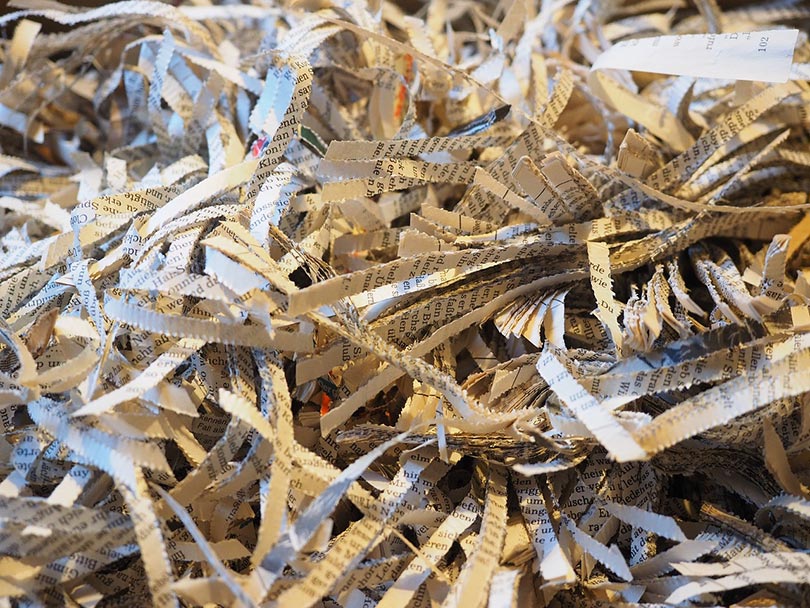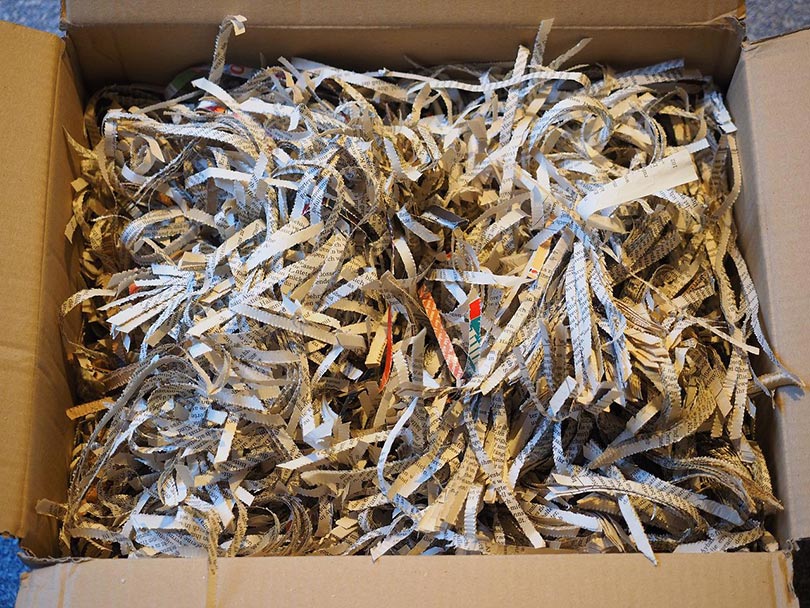Can You Compost Shredded Paper? 2 Simple Ways
-

- Last updated:

Most people forget that paper comes from a natural source, which means it is not dangerous to the environment and can be composted. Paper is made from a couple of ingredients, including plants such as trees, rice, cotton, and hemp, and is treated with chemicals that have a benign impact on the environment.
In this article, we’ll look at ways to compost shredded paper and whether all kinds of paper are safe for the environment.
The 2 Ways You Can Shred Paper for Composting
Before composting your paper, shredding it helps increase the pace at which the paper will decompose. In case you do not own a paper shredder, there are several ways in which you can shred the paper, including:
1. Soaking the Paper
This may take a bit longer compared to a paper shredder, and although it does not essentially shred the paper, it breaks it down, making it easier to decompose.
All you have to do is soak the paper for a few hours and swirl it around to break it down.
2. Cutting With a Pair of Scissors
If you have a small amount of paper to shred, you can use scissors to cut it up. However, this could give your hand muscles quite the workout.

How Do You Compost Paper?
It’s always wise to ensure you do things the right way, and in this case, there is a proper way to compost paper.
The first thing you need to decompose paper is a good container. For example, a stationary bin or a rotating tumbler setup.
Compost requires some sunshine, which means you will need to position your bin where it can get heat and light. You will also need to turn the compost regularly to ensure the biological process is working. If the bin is stationary, you will need a fork or a shovel to turn the compost. A rotating bin is easier because you simply turn the bin and not the compost.
The process may take some time, but if successful, you will finally end up with rich soil perfect for your garden.
How to Compost Cardboard
Before shredding cardboard boxes, the first thing you should ensure is that the cardboard is free from any silicon-based sticky tapes, cellophane, or acrylic. These need to be removed because they don’t degrade as the rest of the paper, and you don’t want to end up with microplastics, toxic chemicals, and greenhouse gasses in your compost.
You will also need to cut the cardboard into smaller pieces, which can then be easily shredded. There are two ways you can go about composting cardboard boxes, which include:
1. Shred and Spread
Place your cardboard boxes in the area you have chosen for composting and place them alongside high-carbon materials such as dead leaves or straw.
Sprinkle some water over the top to create a moist environment for the decomposition process. Microbes and fungi should be present, which helps kickstart and maintain the decomposition process. Keeping the compost wet will also discourage rodents from nesting on the compost.
Add a 4-inch layer of nitrogen-rich materials on top of the leaves and straw. These materials are called greens and will include things like grass clippings, kitchen waste, and animal manure. Keep making more layers like this where you add the leaves and straw followed by greens, one layer after the other.
Finally, add a layer of soil, which should be around 2 inches in thickness. After about 5 days, you can turn the pile over with a shovel to replenish the oxygen in the heap and control the temperature. If you feel the heap is a bit dry, you can sprinkle some water over the top again.
2. The Lasagna Way
For this method, you have to lay down the sheets of cardboard and wet them up, after which you can cover them with a 2-inch layer of soil.
You then cover it up just as you would do in the shred-and-spread method.
This method takes longer but will not require you to aerate the heap, meaning no turning.
How Long Does It Take for Shredded Paper to Decompose?
- The climate
- Microorganisms
- Oxygen
- Type of paper
However, it will take roughly 4–6 weeks for the whole process to be completed.
Types of Paper Safe for Composting
There is a lot of information out there pertaining to the safety of the paper used in composting. There were claims that bleached paper and paper with ink from printers were unsafe and posed a danger while composting.
While this claim may have been true at one time, the paper and printing industries have come a long way from what they once were. Currently, most papers and inks are poison-free and do not pose a danger to the soil and composting material.
Compost made from paper products will have fewer contaminants compared to compost made from yard trimmings
- Bills
- Credit card statements
- Scrap paper
- Notebooks
- Newsprints
- Receipts
- Envelopes
- Office paper
What Should You Be Cautious Of?
Although the current paper quality is made to have as little impact on the soil as possible, there are still possibilities where you will end up with a kind of paper that will result in poisonous compost, which may harm your soil.
For one, highly processed paper may come with metals and poisonous inks and wax that may pose a threat to the environment.
Well-made compost may end up binding most metals into insoluble forms and also break down any harmful compounds. However, it’s better to be safe than sorry. Staying away from such materials is better than hoping the composting process will solve the problem.
- Glossy paper
- Magazine paper
- Colored construction paper
- Paper with metallic ink
- Waxy paper
Benefits of Shredded Paper in the Compost
There are a couple of ways shredded paper can be beneficial as compost material, some of which include:
Encourages Worms
Worms are some of the many microorganisms that are useful in the decomposition of materials into the soil. The shredded paper helps encourage worms in the decomposition process, as they actively seek shelter in the paper.
Increases the Soil Volume
This is more of an input-output situation where the compost with a lot of shredded paper will translate to more soil as the decomposition comes to an end.
Moisture Retention
The paper adds an element of moisture and water retention to the decomposition process. It has natural properties, which are useful in wicking moisture away from decomposing material, translating to a faster breakdown of decomposing material and odor reduction.
Efficient Carbon Use
A healthy compost heap requires around 25–30 parts carbon to 1 part nitrogen, and because the paper is almost entirely carbon, it plays a huge role in providing the necessary carbon required for an efficient decomposition process.
Mulching
Shredded paper is helpful in preventing the growth of weeds when spread on the plant’s roots. The paper will allow essential nutrients, such as water and fertilizer, to reach the plants’ roots while preventing weeds from getting any sun.
Recycling vs. Composting
Anybody concerned about the environment will be curious to find out the better option between decomposing and recycling.
The answer to this depends on factors such as the type of paper, weather, and technical know-how. However, most people who prefer recycling argue that it helps ultimately save trees that would have otherwise been cut to provide paper.
However, proponents of composting argue that recycling will require extra resources, which might harm the environment during the recycling process. By choosing to compost, you get rid of the need for chemicals, trucks used in transporting, and the machinery required.
- Related Read: Is Cellophane Recyclable?
Frequently Asked Questions
Do I need a bulking agent with wet waste?
You will need a bulking agent with some wet waste. The bulking agent will form a supportive structure that will help in maintaining airflow.
Can fast food sandwich wrappers be used for composting?
Pure paper is usable. However, most fast-food wrappers come with plastic labels that are not compostable. If the paper is shiny or coated, it is best suited for landfills.
Which papers are faster at decomposing?
Papers with high-cellulose and low-lignin content are the easiest to decompose. This will include envelopes, drawing paper, and telephone directories.
Conclusion
As mentioned above, shredded paper can be composted. This means you should try and compost as much paper as you can to prevent it from ending up in a landfill.
While it may take some time to decompose, composting is an easy and responsible DIY activity that leaves you feeling better for helping the environment.
See also:
- Composting shredded paper will need a lot of sunshine
- Cardboard is free from any silicon-based sticky tapes, cellophane or acrylic.
- Shredded paper helps encourage worms in the decomposition process
- A healthy compost heap requires around 25 – 30 parts carbon to 1 part nitrogen
- Highly processed paper may have metals and poisonous inks and wax not ideal for composting
Featured Image Credit: Hans, Pixabay
Contents



